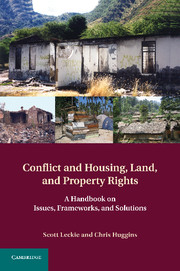Book contents
- Frontmatter
- Contents
- Opening Note and Acknowledgments
- Foreword by Dan Lewis
- 1 Introduction to the Issues – HLP Rights and Sustainable Peace
- 2 The International HLP Rights Normative Framework
- 3 Displacement, Conflict, and HLP Rights
- 4 HLP Restitution Rights
- 5 Restitution Mechanisms and Institutional Frameworks
- 6 United Nations and Other Peace Operations and HLP Rights
- 7 Protracted Displacement and Political Obstacles to the Protection of HLP Rights
- 8 Emerging Conceptual Issues
- 9 Improving International Responses to HLP Rights and Conflict
- Index
- References
4 - HLP Restitution Rights
Theory, Law, and Concepts
Published online by Cambridge University Press: 03 May 2011
- Frontmatter
- Contents
- Opening Note and Acknowledgments
- Foreword by Dan Lewis
- 1 Introduction to the Issues – HLP Rights and Sustainable Peace
- 2 The International HLP Rights Normative Framework
- 3 Displacement, Conflict, and HLP Rights
- 4 HLP Restitution Rights
- 5 Restitution Mechanisms and Institutional Frameworks
- 6 United Nations and Other Peace Operations and HLP Rights
- 7 Protracted Displacement and Political Obstacles to the Protection of HLP Rights
- 8 Emerging Conceptual Issues
- 9 Improving International Responses to HLP Rights and Conflict
- Index
- References
Summary
[T]he basic principle that wrongfully expropriated property should be restituted (or compensation paid) applies to them all, and their implementation of this principle is a measure of the extent to which they have successfully adopted democratic institutions, the rule of law with respect to property rights, and market economy practices. As these governments seek to join western economic and political organizations, and to integrate their economies more closely with ours, we do expect them to adopt the highest international standards in their treatment of property.…
[R]efugees wishing to return to their homes and live at peace with their neighbours should be permitted to do so at the earliest practicable date, and that compensation should be paid for the property of those choosing not to return and for loss of or damage to property which, under principles of international law or in equity, should be made good by the Governments or authorities responsible.
A principled argument in favour of restitution is that no matter how long ago the injustice occurred, its legitimisation only encourages other wrongdoings.
Throughout history, millions upon millions of people have been forced by circumstances beyond their control to flee their homes, lands, and properties. In previous centuries, such displacement and loss of one's habitual residence was often accepted as a tragic but nonetheless inevitable consequence of warfare, military aggression, conquest, arbitrary confiscation of lands, and related gross and systematic violations of human rights.
- Type
- Chapter
- Information
- Conflict and Housing, Land and Property RightsA Handbook on Issues, Frameworks and Solutions, pp. 121 - 154Publisher: Cambridge University PressPrint publication year: 2011

